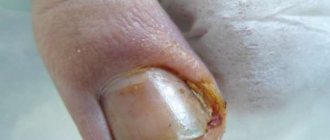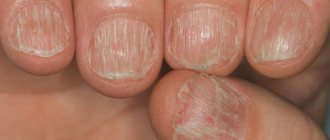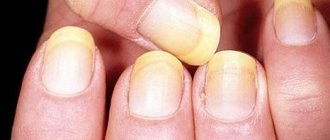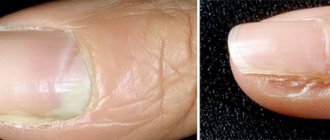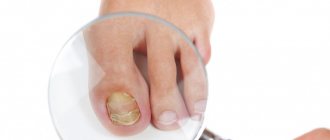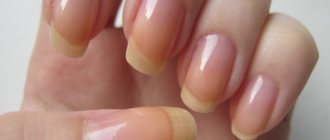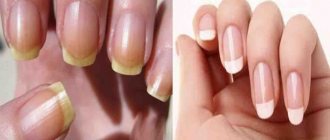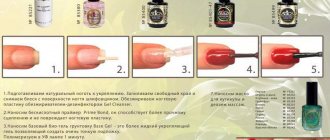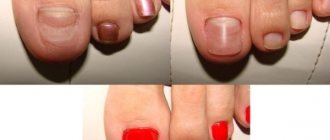Nail fungus
Beautiful and healthy nails always attract the attention of others, and in some cases are considered the key to good health. A deficiency of vitamins and minerals can worsen the condition of the nail plates, but sometimes the problem is deeper, associated with a fungal infection. Nail fungus, or the medical term “onychomycosis,” refers to a common and insidious disease that can completely destroy the nail plate. Why does the disease develop, what are the signs and how to get rid of nail fungus.
Where can you get infected with fungus?
Nail fungus is usually spread from person to person. Microbial spores may remain on surfaces. When you touch them, the fungus will remain on the feet and begin to develop. You can catch mycosis in the following places:
- Public institutions: saunas, swimming pools, showers of sports clubs. This is the most likely way to obtain the fungus, since it multiplies most actively in warm and humid conditions. To protect against it, it is necessary to perform preventive treatment of the feet with medications before going to the institution. You must bring your own slippers;
- If mycosis occurs in a household member, the likely way for the disease to appear in other family members is through taking a bath. Fungal spores remain on its walls, which cause mycosis. For protection, it is necessary to treat surfaces with disinfectant compounds after each visit to the bathroom;
- Sometimes the reason is a manicure or pedicure performed with tools that have not been disinfected after previous use. This refers to procedures carried out in beauty salons;
- Controversies can be hidden in shoes in stores because they are often tried on by different people. For protection, you can try on shoes only on the toe;
- A less likely source of infection is public beaches, since nail fungus does not survive well in salted sand.
To prevent the disease, one should not forget about the importance of personal slippers and use preventive measures.
How it develops
Nail fungus (onychomycosis) is an infectious disease caused by pathogenic fungi - parasites. According to medical observations, the disease is diagnosed in 7% of the adult population. During the development of onychomycosis, pathogenic fungal pathogens infect the tissues of the nail plates, which leads to disruption of their structure.
The source of fungal infection is often parasitic fungi. Infection often occurs in public places (locker rooms, baths, saunas). After attaching to the skin of a healthy person, scales of fungal parasites penetrate the upper layers of the epidermis, begin their active reproduction, release waste products that poison the human body, reduce immune defense, and make the body defenseless against various secondary infections. Spores of pathogenic fungi penetrate into the layers of the nail plate, which begins to lose its natural color, white spots and yellowness appear. If treatment is not carried out at this stage, deformation of the plate will occur, followed by its destruction and damage to healthy toes.
Basically, toenail fungus is a consequence of mycosis, which causes damage to the feet or areas between the toes. In the international classification of diseases, onychomycosis is coded B35.1 and belongs to the category of parasitic and infectious pathologies.
Photo: Pathogens of nail fungus
Treatment of onychomycosis with folk remedies
After visiting a doctor and determining the type and form of the fungal infection, along with the prescribed drug therapy, you can apply some folk advice. Inexpensive and effective treatment with traditional medicine will help speed up recovery.
For example, baths with baking soda dissolved in warm water will help to quickly soften and remove the keratinized layers of the nail.
This treatment every week for six months, until a new and healthy nail plate grows completely, will help keep the nail from deforming. After such a bath, you can treat the affected areas with tea tree or lavender oil.
Potatoes, or rather, their peels, are considered another . It is necessary to steam your feet in potato thickets, rubbing the affected areas with it.
Afterwards, you need to grease your feet and put on socks. This therapy helps to quickly get rid of a fungal infection.
Lemon is very effective in combating the proliferation of fungus . A thin slice of it should be applied to the affected surfaces, secured with a fixing bandage. Such compresses must be done for 10–14 days.
In addition to treating a fungal infection, it is necessary to strictly monitor the hygiene of the affected surfaces. Antifungal agents should be used not only on nails, but also on all places where particles of infected skin may be found.
Important!
Contaminated shoes must also be disinfected, or best of all, thrown away. All socks and stockings, as well as the patient’s bedding, must be thoroughly ironed after washing. It is advisable to soak nail care items (manicure scissors, for example) in alcohol and heat them over an open fire.
Causes and risk factors
The etiology of the disease is based on infection of the nails by pathogenic fungi, including:
- dermatophytes (T. rubrum, T. interdigitale);
- yeast of the genus Candida (C. aibicans, C. tropicalis);
- mold fungi (Fusaria, Alternaria).
In addition to the main cause of the disease, there are a number of predisposing factors that increase the risk of developing onychomycosis. The trigger for the activation of a fungal infection can be:
- lack of nail care;
- diabetes;
- varicose veins;
- obesity;
- injuries;
- wearing tight shoes;
- poor quality pedicure;
- taking potent drugs.
Particular attention in the development of the disease is given to the state of the immune system. With strong immunity, the human body will be able to resist pathogenic flora even after it penetrates the body, but if immunity is reduced, fungal mycelium easily penetrates the epithelium of the nail, which causes inflammatory and dystrophic changes.
Nail fungus should not be considered as an aesthetic problem, since the toxins released by fungi can spread throughout the entire body and cause a number of concomitant diseases.
Photo: Symptoms of fungal nail infection
Types of fungal infections
Nail fungus is divided into types depending on what group of microorganisms it is caused by. There are three main groups:
- Dermatophytes. The most common case. This group is the cause of mycosis in 95% of cases;
- Candida. These yeast-like microorganisms contribute to the thinning of the nail plate. It begins to turn yellow and lag behind its bed. The lesion starts from the nail fold. As the disease develops, swelling occurs. In some cases, pus may be discharged. The skin of the plate stops growing, and therefore it turns brown. The nail is crumbling. These groups of microorganisms usually develop in women. There are risk groups - housewives who constantly deal with household chemicals. It has an aggressive effect on the skin, which opens the “doors” for infections;
- Mold species. These groups of microorganisms cannot penetrate deep into the nail plate. This prevents it from being completely destroyed, but the disease is fraught with other effects. The nail changes its color greatly. It can take on a black, blue, green tint.
Treatment depends on the group of microorganisms, since different pathogenic microbes react differently to drugs. Sometimes, during diagnosis, three types of fungus are detected. In this case, complex therapy will be needed.
Forms of fungus
There are different stages of the disease, differing in the type of lesions:
- Normotrophic. There is a change in the color of the nail plate. It may turn yellow and lose transparency. Stripes or dots of white and yellow appear. The difference between the disease is that the nail is not subject to significant deformation. Sometimes it can even retain its former shine;
- Atrophic. The nail becomes thinner and completely loses its shine. Pronounced white and yellow stripes and dots appear, representing specific foci of infection;
- Hypertrophic. The plate changes significantly. Thickening and signs of crumbling are observed. It becomes porous. Severe pain syndrome is also possible, worsening during movements and wearing tight shoes. The disease can limit a person's activity.
The prescribed treatment regimen depends on the stage, as well as on the type of microorganisms. In the first stages, external remedies have proven effective. In the later stages, the treatment regimen is usually a combination of external medications and agents for internal use.
Clinical signs
Normally, the nail plate is smooth and even, but as a fungal infection develops, its structure is disrupted and its appearance deteriorates. Onychomycosis is a slowly progressive disease. The first signs of the disease are not observed immediately after contact with the pathogen, but after a while, when fungal spores penetrate deep tissues.
Onychomycosis can be recognized by the following signs:
- itching and burning in the interdigital areas;
- small skin cracks on the fingers;
- severe sweating of the feet;
- peeling of the periungual platinum;
- unpleasant odor;
- skin redness;
- thickening of the nail;
- dullness, yellowness and roughness.
Pathological changes are present not only on the nails, but also on the skin of the feet, especially between the fingers and toes.
In dermatology, there are three main stages of onychomycosis:
- Normotrophic type - the disease often goes unnoticed, which leads to its progression. You may notice minor spots or stripes on the nails, it loses its shine, may change its thickness, and itching and burning appear.
- Hypertrophic onychomycosis - there is thickening and deformation of the nail, bird's claw syndrome.
- Atrophic - destruction of the nail plate, the nail moves away from the bed. The only treatment for the atrophic form of the disease is nail removal.
When nails are deeply damaged, the infection penetrates the bloodstream and significantly reduces the functioning of the immune system, thereby increasing the risk of developing other diseases.
Photo: Stages of onychomycosis
How is the disease diagnosed?
To prevent the development of a pathological process, it is necessary to promptly seek help from a doctor. Nail problems are “solved” by a mycologist; if there is no such specialist, you can contact a dermatologist.
Since there are quite a large number of varieties of fungal infections and the symptoms of fungal development are often similar to the manifestation of allergic reactions or vitamin deficiency, only a doctor should determine the form of a fungal infection based on special studies (scraping from the nail and culture analysis).
After identifying the “pest,” the doctor decides which therapy is optimal and which antimycotics are needed in a particular case.
Important!
Self-medication of a fungal infection may not only not bring the desired result, but also increase the risk of developing quite serious complications that threaten the entire body.
Diagnostics
Before treating nail fungus, you need to determine the type of pathogen. The doctor collects anamnesis, conducts an examination, and prescribes tissue scrapings, which will help determine the type of pathogen. If necessary, fluorescent diagnostics will be prescribed, which consists of examining the nail using a Wood's lamp.
After the examination and the results of the examination, the patient will be prescribed treatment.
Photo: Examination of nails by a dermatologist
Additional drugs for healing from illness
Mycosis of the toenails and fingernails takes a long time to treat, sometimes treatment with one remedy does not bring the desired result. In this case, doctors recommend combining therapeutic methods with laser pulses and folk remedies. Patients who have made several attempts to get rid of the disease are interested in how to choose a drug to get rid of the problem forever. If the above medications do not help you, then pay attention to additional remedies.
- Cream Fundizol. It is a universal antifungal drug and helps against mycosis of the nails and feet. Application regimen: twice a day, application is done under a patch and compress pad.
- Creolin is a veterinary disinfectant dosage form for disinfection and removal of fungal spores and harmful bacterial flora. This substance is harmful to the skin, so you should apply it carefully or cover the adjacent areas of the skin with a band-aid. Treatment with creolin is done once a day, sessions continue until the old plate comes off and a new one grows.
- Castellani liquid (Fukortsin) has an effective antifungal effect. Mycosis of the toenails is treated with great care; if the composition gets on nearby tissues, it will cause a burn and damage to the integrity of the skin.
- Berezhnova's liquid should be ordered at the pharmacy; it has long been used for mycosis of the nails, but is now rarely used.
- Those suffering from mycosis of the nails are recommended to take baths with Listerine. To enhance the effect, add vinegar or apple juice to the solution.
Now you know what nail mycosis is, its signs, symptoms and diagnosis, you have received information about the best antifungal agents and you can take timely action to eliminate the problem. We wish you success and health.
Effective Treatments for Fungal Nail Infection
Treatment of onychomycosis is a rather long process, which consists of complex therapy. Modern dermatology provides several effective methods to get rid of onychomycosis. In practice, they most often use:
- systemic antimicrobial and antifungal drugs;
- local antimycotics;
- physiotherapy;
- hardware cosmetology;
- folk remedies;
- surgery to remove a diseased nail.
To achieve the maximum therapeutic effect, in addition to the main treatment, it is important to monitor the hygiene of your feet and nails.
Pharmacy drugs
Modern pharmacology provides a fairly large range of medications that can cure nail fungus. They are produced by different manufacturers in different forms and have different prices. In therapy, drugs with systemic and symptomatic action are more often used. In the first case, the medicine has a detrimental effect on pathogenic fungal pathogens, destroys their cellular structure, and prevents further reproduction and spread. Symptomatic drugs relieve symptoms, relieve itching, peeling, and improve the appearance of the nail.
Treatment of onychomycosis can take from 3 to 6 months, and sometimes more than a year, and there is always a risk of re-infection.
The most effective remedy is etiotropic therapy, which consists of the use of tablets, capsules, local medications - ointments, gels, varnishes.
In practice, antifungal tablets are most often used:
- Ketoconazole.
- Lamisil.
- Fluconazole.
- Griseofulvin.
The active components of such drugs destroy pathogenic fungal flora, block the growth and reproduction of pathogens. Only a doctor can prescribe them individually for each patient.
Local drugs act at the source of inflammation, relieve symptoms, and destroy pathogenic fungal flora:
- Nizoral cream.
- Lac Loceryl.
- Lamisil ointment or spray.
- Mycozoral ointment.
- Fukortsin, Kreolin - solutions for treating nails.
If nail fungus is diagnosed and treated with inexpensive but effective drugs, you need to pay attention to the products of domestic pharmacological companies, the cost of which is several times lower than that of foreign drugs. At the same time, the effect of treatment is similar to expensive drugs.
At the initial stages of the disease or in combination with other treatment methods, a good effect can be obtained from keratolytic agents:
- Set of Mycospores.
- Onychoplast.
- Salipod.
- Ureaplast.
They are produced in the form of a patch, which, after steaming, is glued to the diseased nail. They must be used in accordance with the instructions for use.
Important: After treatment has been completed and the symptoms of the disease have been eliminated, the risk of relapse will always be present, so you need to keep your feet clean and periodically use ointments to prevent recurrence of the disease.
Photo: Drugs for the treatment of onychomycosis
Physiotherapy
Physiotherapeutic treatment of onychomycosis will speed up the recovery period, improve blood circulation, and enhance the growth of healthy tissues. Efficiency has:
- diathermy;
- amplipulse therapy;
- laser treatment;
- paraffin applications;
- darsonvalization;
- magnetotherapy.
Such procedures are prescribed in short courses - up to 10 days.
Folk remedies
Traditional medicine comes to the aid of traditional therapy. Various herbs, improvised remedies, and essential oils are used as medicinal raw materials. Let's look at a few effective recipes:
Soda bath. It has an antimicrobial effect, destroys pathogenic fungal parasites, eliminates unpleasant odor, and allows you to soften the nail before removing it. To prepare, you need to dilute 2 tablespoons of soda in 2 liters of warm water, stir well and keep your feet on for 10 - 15 minutes.
Iodine. A powerful antiseptic that allows you to destroy pathogenic fungal flora. You need to apply the iodine solution to the sore nail, without touching the skin, once every 2 days.
Essential oils. You can get rid of onychomycosis using lavender or tea tree essential oils. It is enough to apply pure oil to the nail using a cotton swab. It is recommended to carry out the procedure before bedtime.
Calamus root. To prepare the medicine, you need to take 30 g of calamus root, pour boiling water, and put on low heat for 5 minutes. Then leave for 1 hour, strain. The resulting decoction can be used to treat nail plates or take 50 ml orally, after diluting it with water 1:1. Treatment should be continued for about 2 weeks.
When using any remedy for toenail fungus, you need to make sure there is no allergy.
Alternative medicine is not a panacea, but still, as a means of prevention or in the initial stages of the disease, it has a good therapeutic effect.
If there is no effect from conservative therapy or the disease is advanced, the doctor prescribes surgery to remove the nail plate. Its implementation will reduce the intake of medications and speed up the recovery period.
Photo: Soda baths in the treatment of nail fungus.
Methods of treating the disease
Not so long ago, the only way to treat fungal nail infections was to completely remove the affected nail plate. But the nail that grew back later also turned out to be infected with a fungus.
Modern medicine resorts to this method only as a last resort (for fairly severe forms of onychomycosis), mainly using the method of hardware treatment of nails; using topical antifungal drugs or special varnishes, as well as systemic medications.
You should always remember that timely treatment of nail fungus may be limited to the purchase of inexpensive drugs - special varnishes or ointments, but a more advanced form of pathology requires an integrated approach to treatment and sometimes surgical intervention.
Prevention
Prevention of onychomycosis consists of following certain rules that every person must adhere to:
- Keep your feet and nails clean regularly.
- Lead a healthy lifestyle.
- Proper and fortified nutrition.
- Treat all concomitant diseases in a timely manner.
By following basic rules, you can significantly reduce the risk of illness. It is important to exclude self-medication at the first signs of the disease; only a dermatologist can tell you how to quickly cure nail fungus and eliminate all sorts of complications of the disease. If there is a patient with onychomycosis in the house, his relatives need to exclude all possible contact with his things, since there is a high risk of infection for the entire family.
Video: Doctor Dermatologist onychomycosis
Possible complications
In addition to aesthetic discomfort and quite unpleasant sensations that significantly worsen a person’s quality of life, advanced fungus causes loss of the nail plate.
But this is not the worst thing - attention : fungal spores, in the process of their life activity, release toxins dangerous to the human body (for example: penicillin; substances similar to antibiotics and viomellein), which enter through the blood into all internal organs and systems, provoking the development of many infectious complications, diseases of the endocrine system and even diabetes. Nail fungus is a dangerous infection and requires treatment.
What increases the chances of infection?
Indeed, not all visitors to bathhouses and beaches are affected by this disease. So why does it seem to avoid some, while successfully parasitizing others? What factors contribute to increased risks?
Causes of nail fungus. The worse the boots are ventilated, the more they fog up inside, creating a favorable environment for fungal infection.
- Prevention Closed , warm shoes, and even with feet that are sweaty or wet from a puddle, are an excellent chance for the fungus to manifest itself. His favorite conditions are combined here: dampness, warmth, darkness.
- Doctors often diagnose nail fungus in older people . Doctors argue that with age, the growth rate of the nail plate slows down, and the level of the acidic environment of the skin, which rejects the fungus, decreases.
- Frequent cuts and injuries to the skin of the hands and feet near the nails. One of the many functions of the skin is protection against parasitic influences. Violating its integrity, the spores “easily and naturally” penetrate the skin and begin development from there.
- Weak immune system . It plays a similar role in this regard to the skin. Impaired immunity makes it several times easier for the fungus to penetrate.
- Diseases that provoke onychomycosis. These include heart failure, varicose veins, excess weight, diabetes, psoriasis, diseases of the circulatory system, etc.
- Abnormal development of the nail plate or foot.
